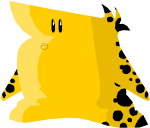
Tuesday, April 28, 2009
Saturday, April 18, 2009
The Temple
 Today Ben went to the temple for the first time. I think he had a great experience. It was with the whole stake, so it was a large group. I'm so glad that he had a chance to go and serve there at the temple.
Today Ben went to the temple for the first time. I think he had a great experience. It was with the whole stake, so it was a large group. I'm so glad that he had a chance to go and serve there at the temple.He's lounging on the couch right now with his left hand playing with his hair. He will probably start snoring in a moment. They left this morning at seven, so I think he's tired.
Thursday, April 16, 2009
The Bunny
This was published last week in Ben's core newsletter.
Which Came First, the Easter Bunny or the Easter Egg?
By: Ben Murphy
The Easter bunny originated in Alsace and southwestern Germany, where it was first mentioned in German writings in the 1600s. During the 1700s, German settlers who arrived in the Pennsylvania Dutch country introduced the bunny to America. According to tradition, children would bring brightly colored nests, often out of caps and bonnets, in selected areas of their homes. The first edible Easter bunnies were made in Germany in the early 1800s and were made of pastry and sugar. Clearly, the bunny came first.
The bunny may be credited for leaving and laying the eggs today, but originally the eggs came from a strange bird. The Oschter Haws (means ostrich chase) would, if the children had been good, lay brightly colored eggs in their nests or baskets. So, instead of looking for the Easter bunny, look for the Easter ostrich.
The Easter bunny is depicted as an anthropomorphic (has human characteristics) rabbit. In legend, the creature brings baskets filled with colored eggs, candy, and toys to the homes of children on the night before Easter. The Easter bunny will either put baskets in a specific place or hide them somewhere to find when they wake up in the morning.
In conclusion, remember to be good this Easter, but don’t try to catch the bunny or the ostrich because then you would be considered really, really bad.
Which Came First, the Easter Bunny or the Easter Egg?
By: Ben Murphy
The Easter bunny originated in Alsace and southwestern Germany, where it was first mentioned in German writings in the 1600s. During the 1700s, German settlers who arrived in the Pennsylvania Dutch country introduced the bunny to America. According to tradition, children would bring brightly colored nests, often out of caps and bonnets, in selected areas of their homes. The first edible Easter bunnies were made in Germany in the early 1800s and were made of pastry and sugar. Clearly, the bunny came first.
The bunny may be credited for leaving and laying the eggs today, but originally the eggs came from a strange bird. The Oschter Haws (means ostrich chase) would, if the children had been good, lay brightly colored eggs in their nests or baskets. So, instead of looking for the Easter bunny, look for the Easter ostrich.
The Easter bunny is depicted as an anthropomorphic (has human characteristics) rabbit. In legend, the creature brings baskets filled with colored eggs, candy, and toys to the homes of children on the night before Easter. The Easter bunny will either put baskets in a specific place or hide them somewhere to find when they wake up in the morning.
In conclusion, remember to be good this Easter, but don’t try to catch the bunny or the ostrich because then you would be considered really, really bad.
Subscribe to:
Comments (Atom)


